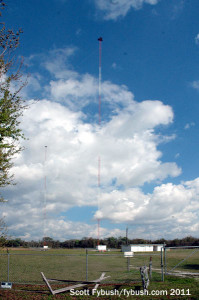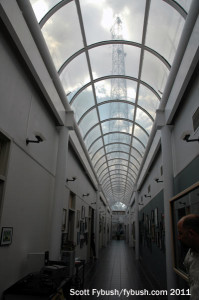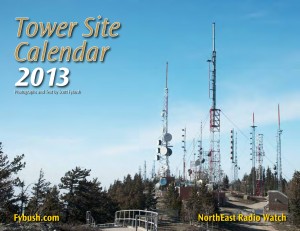NorthEast Radio Watch 12/8/2025: Cichon’s Back in Buffalo
In this week’s issue… Veteran newsman returns - Remembering NY's Leitner, RI's Jones - CT AM saved - Maine AM moves - "Indie" adds suburban signals
Text and pictures by SCOTT FYBUSH
By the time many of our regular readers see this week”s installment, much of NERW”s home turf in the northeast could be buried under three feet or more of snow. And even if our headquarters territory in western New York is expected to dodge the worst of the storm, with “only” a foot at most, it”s still a wonderful excuse to keep digging through the files and present more of our visit to Florida back in February and March 2011.


This week”s installment brings us into the Orlando market, the first time we”d been there since the obligatory childhood visit to Disney World.
With all the traveling we”d done since then, Orlando stands out geographically as one of only a few places where the typical tourist experience is so completely disconnected from the typical “local” scene. You won”t find many native Bostonians regularly walking the Freedom Trail or New Yorkers dining in Times Square, but the tourists doing their tourist thing at least cross paths extensively with the locals in the same general area.
Orlando, however, takes more after Las Vegas: just as the average Vegas visitor rarely strays more than a block or so from the Strip while the average Vegas local avoids the area intensely, the average Orlando visitor stays tightly confined to a narrow theme-park corridor along I-4 at the southern end of the sprawling metropolis. What I didn”t know back in 1986 was that most Orlando locals never venture that far south – and that I wasn”t seeing very much broadcast anything back then because all of that infrastructure is, for the most part, where the “real” Orlando is found, which is on the north side of town.
We”ll start our look at the market with the oldest signal in Orlando. WDBO (580) signed on back in 1924 as the 50-watt voice of Rollins College in Winter Park, now a north-side Orlando suburb but then a town just as significant in its own right as little Orlando. WDBO changed owners and locations several times in its first decade, but by 1936 had settled down with studios in a downtown hotel and a transmitter facility at the Dubsdread Country Club.
WDBO”s current two-tower directional array is about two miles north of that 1936 site, on Kennedy Boulevard in Eatonville, west of I-4 and about eight miles north of downtown, and while we didn”t get a tour of that site, we did get to spend some quality time at the studio complex that WDBO and its sister stations have occupied since 1986.
When WDBO moved to this facility at 4192 N. John Young Parkway (also on the north side, about two miles away from the 580 transmitter facility), it had recently changed hands from the Rhode Island-based Outlet Company to Katz Broadcasting, which was in turn in the process of being absorbed into the Connecticut-based New City group…which would in turn be swallowed by what”s now Cox Media Group a decade later.
Back in 1986, WDBO was part of an AM-FM pair that included WWKA (92.3), which had signed on in 1947 as WDBO-FM, the market”s first FM signal, and when the stations moved from the studios they”d occupied since 1947 on S. Ivanhoe Boulevard, the new facility on John Young was once again designed for just two stations.
NewCity added a second FM, Daytona Beach-licensed WCFB (94.5), in 1992, followed shortly afterward by another AM, which became WZKD (950). Cox, meanwhile, entered the market in 1996 by swapping its Chicago FMs (WCKG 105.9 and WYSY 107.9) to Infinity in exchange for WHTQ (96.5) and its longtime AM partner WHOO (990), along with a newer FM, WMMO (98.9). By 1997, Cox had swallowed NewCity, creating a seven-station Orlando cluster. In 1999, WZKD was swapped off to religious broadcaster WTLN in nearby Apopka in exchange for the former WTLN-FM (95.3), which was moved into Orlando with a new city of license of Maitland. And in 2001, the 990 signal was sold off to Disney to become Radio Disney outlet WDYZ, leaving Cox with its present lineup of one AM and five FMs.
With all those stations, space was tight in the original 1986 building on John Young, which is why a big addition on the back side of the building went up a few years ago to provide new office space, allowing the original building to be dedicated almost entirely to studios and broadcast operations. The two buildings are separated by a long courtyard and linked by a new lobby at the end of the courtyard; from there, visitors can turn right to go into the offices in the new building or left to enter the original renovated building.
We go left, of course, past a recently renovated rack room and two newer studios used by WPYO (95.3, now urban “Power 95.3”) and WMMO (an early pioneer of the AAA format when it debuted in 1990, now doing straight-ahead AC), and then down the long main hallway past WCFB (adult R&B “Star 94.5”) and WHTQ.
WDBO and WWKA occupy the original 1986 studio core, separated by the WDBO newsroom, which opens into a news booth that in turn looks into the main WDBO control room. WDBO was still spinning music back in 1986, and its studio even featured a covered pair of turntables for the occasional LP to be played on the air. But as a news-talker, what WDBO really needed room for was more wiring blocks – and those ended up where the turntables once sat!
In the summer of 2011, a few months after this visit, Cox upended its format lineup in Orlando. WHTQ”s rock format went away, and in its place WDBO migrated to FM at 96.5, yielding up the AM 580 signal (after a simulcast that lasted more than a year) to go all-sports as “ESPN 580.”
So where are the transmitters for Cox”s FMs? The two biggest Orlando signals, 92.3 and 96.5, are out at the Bithlo tower farm far to the east, which will get a Site of the Week to itself later this month. WCFB, licensed to Daytona Beach, transmits from a site way up north in Paisley, Florida, where its 1500-foot tower was toppled by a tornado in 2007 and replaced by a new tall tower a year later. We didn”t get up there on this trip (though Mike Fitzpatrick made it there a year or so later and featured it on NECRAT.us), but we did see a small piece of WCFB”s recovery.
After the big 1500-footer went down on Thursday, Feb. 1, 2007, Cox moved WCFB”s temporary replacement signal to several sites as it tried to get the best facility on the air as quickly as possible. Within 10 hours of the collapse, WCFB was on the air at low power from the 92.3/96.5 combined site out at Bithlo, but only at very low power. By the following Monday, it was on the air at 18 kW from the center of the market from the site we”re looking at right now.
This five-tower site sits on Silver Star Road just over a mile west of the Cox studios, and it traces its history back to the old WHOO (990)/WHOO-FM (96.5), which I believe were on the air from this location all the way back to their debut in the late 1940s. The AM station eventually boosted power all the way to 50 kW daytime from two towers here and 10 kW at night from four towers arrayed in a very squished rhombus – and the FM station used a taller tower right in the middle of the rhombus, behind the transmitter building, detuned so it didn”t affect the AM array.
Cox extensively rebuilt the site in 1999, reworking it into a modern multi-user facility much like the other community FM/TV sites we”ve seen everywhere from Minneapolis to Albany to St. Louis. But this multi-user site is the only one we”ve seen where behind one of those doors along the main hallway lurks not another FM or TV site but instead a 50 kW Harris AM transmitter (and Continental backup) and a big phasor.
In addition to the AM (now Radio Disney”s WDYZ), Cox has relocated two of its FMs here: class C3 WPYO (95.3) on a two-bay ERI antenna, and class C2 WMMO (98.9) on the six-bay ERI at the top of the tower. (The tower”s original occupant, 96.5, isn”t here anymore, of course – and there”s a whole treatise we could write about WMMO”s own fascinating history, including its original 1990 transmitter facility with antenna bays inside the spire of a downtown office tower, not to mention the station”s interesting early ties to Rochester, which gave it founding PD Cary Pall and its original CP callsign, WEZO.)
It”s hard to get a good picture of all five towers at this site, which now sits behind a self-storage facility at the end of “Whoo Radio Road,” but you can see our best efforts above – including the four-bay ERI (mounted below the WPYO antenna) that was the temporary home of WCFB in early 2007. Because this site didn”t provide useful city-grade coverage of WCFB”s city of license, Daytona Beach, 94.5 didn”t stay here long; it eventually moved north to a taller tower near Orange City before the Paisley tower was rebuilt a year later. (You can read more about WCFB”s reconstruction in a by Steve Fluker, and see some gory photos of the tornado damage at CFLRadio.net.)
Thanks to Cox Radio Orlando”s Larry Bornacelli and Steve Fluker for the tours!
 It’s 2013! Do you have your Tower Site Calendar 2013 yet? We’ve still got some left, and they’re shipping right away from the all new Fybush.com store! Order now and your wall can be festooned with Florida and much more all through 2013. (We’ve also got the very last FM Atlas copies available for sale, and the new edition of the National Radio Club’s AM Log.)
It’s 2013! Do you have your Tower Site Calendar 2013 yet? We’ve still got some left, and they’re shipping right away from the all new Fybush.com store! Order now and your wall can be festooned with Florida and much more all through 2013. (We’ve also got the very last FM Atlas copies available for sale, and the new edition of the National Radio Club’s AM Log.)
Want access to more than a dozen years’ worth of Tower Site of the Week? All our archives, fully searchable, are available to Fybush.com subscribers – and you get full access to NorthEast Radio Watch, too! Subscriptions start at just $15. Sign up here!
And don’t miss a batch of Orlando IDs next Wednesday, over at our sister site, TopHour.com!
Next week: Orlando, 2011 (part 2)
In this week’s issue… Veteran newsman returns - Remembering NY's Leitner, RI's Jones - CT AM saved - Maine AM moves - "Indie" adds suburban signals
In this week’s issue… Scripps stations face takeover - Sinclair moves more affiliations - CT stations sold - Maine AM surrendered - Remembering WVBR's Shapiro, WABC's Morgan
In this week’s issue… CT TV legend succumbs to cancer - Remembering PA's Adams - FCC still stalled by shutdown - Pittsburgh morning host exits
In this week’s issue… FCC faces reopening challenges - Veteran Boston anchor retires - Morning shift in Toronto - NYC FMs expand reach